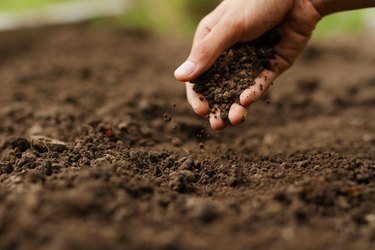
The ideal garden bed for most plants, including fruits and vegetables, is filled with a humus-rich, loamy soil. The dark, crumbly soil, full of decomposed plant and animal materials and beneficial bacteria, provides the nutrients and good drainage that plants need to thrive. To improve your garden soil, dig in generous amounts of compost to lighten and enrich the soil. Over time, the compost finishes the decomposition process to make humus-rich garden soil.
Comparing Humus vs. Compost
Video of the Day
The humus-rich soil definition is that dark, crumbly and fully decomposed organic matter is mixed with the soil to make a nutrient-rich, well-drained medium where plants will thrive. A humus-rich soil contains a balance of clay, silt and sand particles plus this organic matter.
Video of the Day
Clay is the smallest soil particle, and while it holds water, it also compacts into a hard, concretelike surface when it dries out. The largest soil particle is sand, which has much larger spaces between the grains. Water and nutrients move quickly through sandy soils and out of reach of plant roots. Silt particles are in between the sizes of clay and sand. The ideal proportions of soil particles in loam are one part clay to two parts each of sand and silt.
In addition to the soil particles, when building a humus-rich loamy soil, you might add 30 percent or more of compost to the top few inches of the garden bed. Compost, however, is not humus. Compost is the intermediate step in the decomposition process. Once incorporated into the soil, compost finishes decomposing and becomes humus.
Making Compost at Home
While you can buy bags of compost, the essential ingredients are scattered across the lawn and in your kitchen scraps. Composting is a process that may take weeks or months depending on your method. The smaller the pieces you put on the compost pile, the faster they will decompose.
A compost pile is made up of three parts: green materials, including fresh grass clippings, kitchen scraps, coffee grounds and manure; brown materials, including shredded paper, dead leaves, dried grass and twigs; and water. A backyard compost pile should measure at least 3 x 3 x 3 feet. Start with a layer of cardboard, branches or both laid over grass or bare soil and then alternate 3- to 6-inch layers of green and brown materials, sprinkling with water between each layer. To jump-start the decomposition process, add a few shovelfuls of finished compost or garden soil or a few handfuls of 10-10-10 fertilizer.
Keep the compost pile damp but not waterlogged. Cover it with a tarp when rain threatens. Use a long-stemmed thermometer to measure the temperature of the interior and turn the pile when the temperature rises to between 150 and 160 degrees Fahrenheit. A hot compost pile produces finished compost in two to three months, while cold composting, which doesn't require turning the pile, can take 12 months or more for the elements to decompose.
Adding Compost to the Soil
When preparing a garden bed for planting, remove any vegetation, roots, sticks and rocks. Spread 2 to 4 inches of compost over the soil and dig it in to a depth of 8 to 12 inches or deeper. If the soil is very poor, add extra compost and other amendments as needed to adjust the soil pH and add nutrients.
If the compost is ready at the end of summer, consider digging it into the garden bed and then raking an extra 2 to 4 inches of compost or mulch over the amended soil. This allows the decomposition process to continue through the winter months.
Compost is also ideal for raised beds; it will decompose into a rich humus over time. Cover the soil at the bottom of the raised bed with cardboard. If gophers are a problem, use hardware cloth. Thoroughly mix equal parts compost and garden soil or topsoil. Fill the raised bed and moisten the mix before adding seeds or transplants or let it sit all winter and just top it off in spring with extra compost or planting mix.